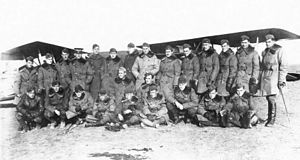| 139th Aero Squadron | |
|---|---|
 139th Aero Squadron, Souilly Aerodrome, France, November 1918 | |
| Active | 21 September 1917 – 17 June 1919 |
| Country | |
| Branch | |
| Type | Squadron |
| Role | Pursuit |
| Part of | American Expeditionary Forces (AEF) |
| Fuselage Code | "Flying Mercury" |
| Engagements | World War I |
| Commanders | |
| Notable commanders | Lt. David Endicott Putnam (Acting) Maj. Lawrence C. Angstrom[1] |
| Insignia | |
| 139th Aero Squadron Emblem |  |
| Aircraft flown | |
| Fighter | Nieuport 28, 1918 SPAD VII, 1918 SPAD XIII, 1918–1919 |
| Trainer | Curtiss JN-4, 1917 |
| Service record | |
|---|---|
| Operations |
2d Pursuit Group Western Front, France: 12 June-11 November 1918[2] |
| Victories |
34 aircraft[3] Air Aces: 7
|
The 139th Aero Squadron was a United States Army Air Service unit that fought on the Western Front during World War I.
The squadron was assigned as a day pursuit (fighter) squadron as part of the 2d Pursuit Group, First United States Army. Its mission was to engage and clear enemy aircraft from the skies and provide escort to reconnaissance and bombardment squadrons over enemy territory. It also attacked enemy observation balloons, and performed close air support and tactical bombing attacks on enemy forces along the front lines.[5]
The squadron was very successful in combat, having half a dozen air aces including David Putnam, Karl Schoen, Robert Opie Lindsay, and future Brigadier General Harold H. George.[6][7]
After the 1918 Armistice with Germany, the squadron returned to the United States in June 1919 and was demobilized.[1][8] There is no current United States Air Force or Air National Guard unit that shares its lineage and history.
- ^ a b Series "E", Volume 17, History of the 104th–147th Aero Squadrons. Gorrell's History of the American Expeditionary Forces Air Service, 1917–1919, National Archives, Washington, D.C.
- ^ Series "H", Section "O", Volume 29, Weekly Statistical Reports of Air Service Activities, October 1918 – May 1919. Gorrell's History of the American Expeditionary Forces Air Service, 1917–1919, National Archives, Washington, D.C.
- ^ Gorrell's History of the American Expeditionary Forces Air Service, Series M, Volume 38, Compilation of Confirmed Victories and Losses of the AEF Air Service as of 26 May 1919
- ^ Franks, Norman; Bailey, Frank W. (1992). Over the Front: A Complete Record of the Fighter Aces and Units of the United States and French Air Services, 1914–1918. Toronto, Ontario, Canada: Grub Street. ISBN 978-0-948817-54-0.
- ^ Maurer, Maurer (1978). The US Air Service in World War I (PDF). Vol. 1. Washington, DC: Office of Air Force History, United States Air Force. ISBN 978-1477602-74-4. Archived from the original (PDF) on 27 September 2013. Retrieved 2 September 2013.
- ^ American Aces of World War I. p. 87.
- ^ "David Endicott Putnam". www.theaerodrome.com. Retrieved 23 June 2010.
- ^ Order of Battle of the United States Land Forces in the First World War, Volume 3, Part 3, Center for Military History, United States Army, 1949 (1988 Reprint)